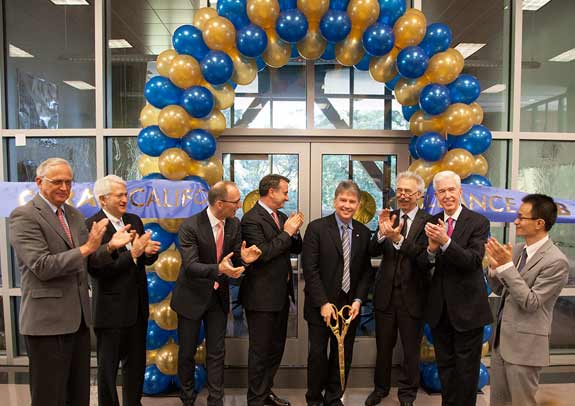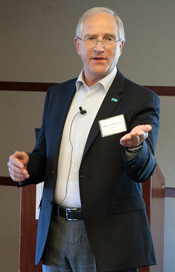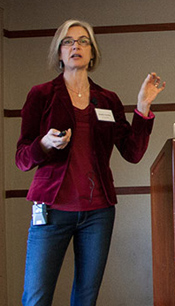College of Chemistry launches research hub with BASF, UCLA and Stanford
The College of Chemistry has launched a new collaborative research center, the California Research Alliance by BASF (CARA), a multidisciplinary effort focused on innovation and technology transfer. Along with Berkeley and the chemical company BASF, CARA academic partners include UCLA and Stanford University.

The opening event, on April 2, featured a scientific symposium and a ribbon-cutting ceremony in Hildebrand Hall, the location of the new center. Speakers at the ceremony included Berkeley and BASF research leaders, UC Berkeley Chancellor Nicholas Dirks and UCLA Chancellor Gene Block, and a special guest, former California Governor Gray Davis.
CARA will operate on a hub-and-spoke model, with the college acting as the headquarters and coordinator of research projects. CARA funding will create ten postdoctoral positions and extend existing research partnerships with the member universities. Currently, four BASF researchers are working at the college.
CARA is led by Berkeley chemistry professors Peidong Yang and Omar Yaghi, along with BASF Senior Research Manager Kerstin Schierle-Arndt. The directors will be supported in bioscience topics by Berkeley chemistry professor Matt Francis and BASF Vice President Klaus-Juergen Schleifer.

According to Chancellor Dirks, “The global challenges we face related to energy, health, the environment and sustainability are very real and have serious implications for our planet and our quality of life. Both basic and applied research are needed in these areas to understand the nature of the challenges and to develop long-term solutions. Constructive collaboration between academia and industry is necessary if we hope to translate our research into innovations for the public’s benefit.”
“The West Coast area is an innovation landscape of high relevance,” said Dr. Andreas Kreimeyer, BASF Member of the Board of Executive Directors and Research Executive Director. “Using the creative spirit of this environment and pairing it with the broad expertise of BASF, UC Berkeley, Stanford and UCLA in the fields of bioscience and inorganic materials, we want to develop solutions beyond the borders of chemistry and biology.”
The center will focus on inorganic materials and techniques for the electronic industry. One of the challenges researchers will confront is the need to reduce feature size in semiconductor computer chips for ever-smaller electronic devices. This opens up opportunities for new materials and new manufacturing techniques.
Another area of focus will be renewable energy, including more efficient photovoltaics made from earth-abundant materials and devices that harness artificial photosynthesis to produce fuels from sunlight. Advances in metal organic frameworks (MOFs) will enable the safe storage of zero-carbon and low-carbon fuels onboard vehicles, and the scrubbing of carbon dioxide from power plant smokestacks.
In the biological realm, CARA research will elucidate the molecular pathways that lead to either the therapeutic benefits or the toxicological effects of biologically active compounds. Understanding these pathways will help to develop safer drugs, plastics and agricultural chemicals. Other biological research topics will include creating protein assemblies and other nanoscale structures to delivery anti-cancer molecules directly to tumors.

CARA was first envisioned when Omar Yaghi, then at UCLA, met and began to work with former Governor Gray Davis on a topic of interest to them both—joint university/industry research centers where scientific innovations could be quickly commercialized via the technology transfer process.
In the year 2000, Governor Davis created the California Institutes for Science and Innovation at the University of California. These institutes were designed to increase the state's capacity for creating the vital knowledge and highly skilled people needed to expand the California economy into new industries and markets.
In recognition of his instrumental role in their creation, the institutes have been renamed the Governor Gray Davis Institutes for Science and Innovation. The headquarters for two of the centers, The California Institute for Quantitative Biosciences (QB3) and the Center for Information Technology Research in the Interest of Society (CITRIS), are located on the Berkeley campus.
Davis and Yaghi, now a senior professor at Berkeley, worked with BASF to bring about CARA. Says College of Chemistry Dean Douglas Clark, “CARA represents the new wave in corporate-academic partnerships, a collaborative intersection of the brightest minds that work on the molecular and nanoscale to achieve incomparable 21st century innovation for real-world issues in energy, health, the environment and sustainability.”
BASF
BASF is the world’s largest chemical company. Its portfolio ranges from chemicals, plastics, performance products and crop protection products to oil and gas. BASF combines economic success with environmental protection and social responsibility. Through science and innovation, BASF enables its customers in nearly every industry to meet the current and future needs of society. BASF products and solutions contribute to conserving resources, ensuring nutrition and improving quality of life.
